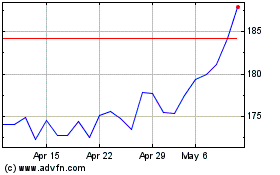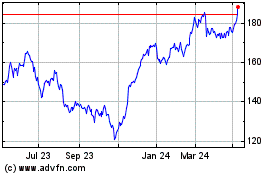By Wayne Ma
HONG KONG--Hong Kong businessman Daniel Cheng was meeting
clients in southern China on Aug. 11 when an urgent message from
his finance manager appeared on his phone: The Chinese yuan had
dropped 2% against the dollar.
Mr. Cheng was stunned. For the past three years, his revenues
soared from selling wastewater treatment equipment to
coal-gasification plants in China. His bottom line was boosted by a
steadily strengthening Chinese currency that made the parts he
purchased in euros from overseas suppliers such as Germany's
Siemens AG and France's Schneider Electric SE cheaper to
import.
Now he needed a rethink. Having just banked a payment of around
10 million yuan, he had to decide what to do with it. He advised
his manager to sit tight in case the yuan bounced back.
By the time Mr. Cheng was back in Hong Kong a day later, the
yuan had slipped further. Alarmed that it appeared the Chinese
government was deliberately allowing the depreciation, Mr. Cheng
bit the bullet and ordered his yuan stash be converted to Hong Kong
dollars, a currency pegged to the U.S. dollar. He took a 3% hit in
the process.
China's surprise decision to allow its currency to more closely
reflect market valuations caught everyone doing business in or with
the world's second-largest economy off guard. The delayed reaction
by Mr. Cheng was typical of business owners because each had to
make complex calculations depending on factors such as where they
make and sell their products, and in what currencies they do
deals.
Even a small move in currencies can be the difference between
profit and loss for companies working in China's hypercompetitive
industries, where factory product prices have declined for more
than three years.
In Mr. Cheng's case, the move hurt him two ways. Besides losing
out converting revenue made in China--his biggest market--it also
increased the cost of the imported components he bought in euros.
Even so, he said his operating margins meant he could absorb the
loss and remain profitable.
While the yuan has stabilized at about 2.8% down on the dollar
from Aug. 10, the central bank's decision has raised fears among
business owners that China's economy may be slowing more than
thought. Investors are further spooked by plummeting Chinese stock
prices that have wiped 38% off Shanghai's benchmark index since
mid-June.
Jolted by the currency move, Mr. Cheng, managing director at
Hong Kong-based Dunwell Group, is now seeking to readjust his
operations.
Mr. Cheng has contacted foreign suppliers to ask that they quote
prices in yuan. "We have to pay in whatever currency they ask for.
They won't lock in the price for us," Mr. Cheng said at his office,
located next to one of the firm's manufacturing plants in a Hong
Kong industrial park. "We're not a giant company...we don't have
that kind of leveraging power."
Mr. Cheng also started scouring for replacement suppliers within
China.
Mr. Cheng's exposure to the yuan has increased over the past
three years as China replaced Hong Kong as his main market. He has
hived off as much as 70% of manufacturing to China and sources more
parts there to reduce currency risk, but he continues high-end
assembly in Hong Kong and still needs foreign parts.
Sourcing products from within China is an effective way to
reduce risk. Willy Lin, the managing director of a half-century-old
family firm making sweaters in China, moved all its manufacturing
to China from Hong Kong around the turn of the century. That was
just as the yuan ended its peg and began a long march of
appreciation against the dollar, increasing costs of imported raw
materials including cashmere yarn. Now he sources 90% of his raw
materials in China. Mr. Lin stands to gain from overseas sales if
the yuan's value remains lower or slips further, because he is paid
by overseas customers in foreign currency.
Mr. Lin's trading savvy comes from hard-earned lessons over the
past three decades. He weathered a massive Chinese devaluation of
the yuan in 1994, when it dropped by a third after China first
unified exchange rates for domestic and foreign companies. And, in
the 1997 Asian financial crisis, he dealt with jumping labor costs
in China as its then dollar-pegged yuan soared relative to Asian
neighbors such as Thailand, where currencies were depreciating.
Mr. Lin, like many Hong Kong businessmen whose fortunes are
closely intertwined with China, protects himself against volatility
by buying currency in advance at fixed rates through forward
contracts.
Such tactics are common among those most heavily exposed to
foreign currency swings, such as Stanley Lau, who manufactures
watches for high-end brands. His firm imports components from
Europe to assemble at his factory in southern China and then sells
the finished products back overseas, with most of his deals done in
Swiss francs.
When the Swiss franc depreciated after he booked an order, he
earned less than he thought on the deal. As a result, he hedges
about half his risk.
"We pay a little bit of premium for the insurance," he says.
That premium is going up. Before the Aug. 10 devaluation, a
company would have paid a 2% premium to hedge its exposure to the
Chinese yuan for six months. Since then, the premium has more than
doubled to 4.67%.
Mr. Cheng, the wastewater treatment entrepreneur, said he
doesn't think the cost of hedging is worth it for the size of deals
he makes.
His company's wastewater systems are custom-designed, he said,
so sometimes there are so many parts bought in different currencies
that fixing the cost of one of them wouldn't make sense.
With profit margins ranging between 15% and 20%, Mr. Cheng's
firm has a cushion that other manufacturers, such as textiles
makers, don't have, he said. Besides, he said, the currency move
was relatively small.
"It's not the end of the world," he said. "The important thing
is to try to get the next job."
Anjani Trivedi contributed to this article.
Write to Wayne Ma at wayne.ma@wsj.com
Subscribe to WSJ: http://online.wsj.com?mod=djnwires
(END) Dow Jones Newswires
August 24, 2015 13:45 ET (17:45 GMT)
Copyright (c) 2015 Dow Jones & Company, Inc.
Siemens (TG:SIE)
Historical Stock Chart
From Mar 2024 to Apr 2024

Siemens (TG:SIE)
Historical Stock Chart
From Apr 2023 to Apr 2024
